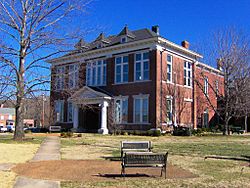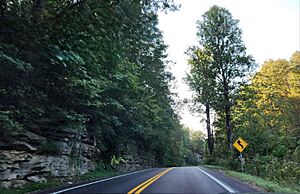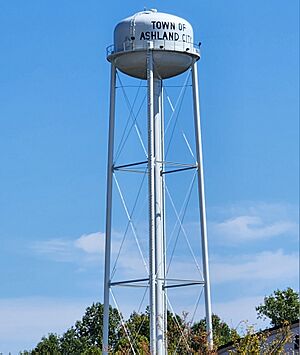Ashland City, Tennessee facts for kids
Quick facts for kids
Ashland City, Tennessee
|
|
|---|---|

Cheatham County Courthouse in Ashland City
|
|

Location of Ashland City in Cheatham County, Tennessee
|
|
| Country | United States |
| State | Tennessee |
| County | Cheatham |
| Founded | 1856 |
| Incorporated | 1859 |
| Area | |
| • Total | 11.41 sq mi (29.56 km2) |
| • Land | 10.67 sq mi (27.63 km2) |
| • Water | 0.75 sq mi (1.93 km2) |
| Elevation | 430 ft (130 m) |
| Population
(2020)
|
|
| • Total | 5,193 |
| • Density | 486.78/sq mi (187.95/km2) |
| Time zone | UTC-6 (Central (CST)) |
| • Summer (DST) | UTC-5 (CDT) |
| ZIP code |
37015
|
| Area code(s) | 615, 629 |
| FIPS code | 47-02180 |
| GNIS feature ID | 1304885 |
Ashland City is a town and the county seat of Cheatham County, Tennessee. Located in Middle Tennessee, it is part of the Nashville-Davidson–Murfreesboro–Franklin, TN Metropolitan Statistical Area. As of the 2020 census, the town's population was 5,193.
History
Ashland City was created in 1856 as a county seat for the newly established Cheatham County. The county's commissioners purchased the initial 50 acres (0.20 km2) of land (now the courthouse square) from James Lenox, and a temporary courthouse was erected shortly thereafter. The temporary structure was replaced by the present courthouse in 1869. Ashland City was officially incorporated in 1859.
The first major industry in the Ashland City area was a forge operated by Montgomery Bell at the Narrows of the Harpeth, several miles to the southwest, which was established in 1818. In 1835, Samuel Watson established a gristmill and powder mill along Sycamore Creek, just north of Ashland City. Watson's mill developed into one of the largest powder mills in the South, making it a target during the Civil War. The mill continued in operation under various owners until 1904.
The city was either named after Henry Clay's estate Ashland or by an act of the General Assembly of Tennessee in 1859, when the city was incorporated, who were inspired by the ash trees in the area. Originally called Ashland, "City" was added to the name after the incorporation.
Geography
Ashland City is located near the center of Cheatham County in a bottomland along the northeast bank of the Cumberland River, a few miles upstream from the river's confluence with the Harpeth River. The Cheatham State Wildlife Management Area covers most of the hilly area on the opposite side of the Cumberland.
Ashland City is centered on the junction of Tennessee State Route 12, which connects the town with Nashville to the southeast and Clarksville to the northwest, and Tennessee State Route 49, which connects the city to Springfield and Kentucky to the northeast and Charlotte to the west.
According to the United States Census Bureau in 2010, the town has a total area of 10.8 square miles (28.1 km2), including 26.2 square kilometres (10.1 sq mi) of land and 0.77 square miles (2.0 km2), or 6.95%, water.
Landmarks
Sydney's Bluff, located on the opposite bank of the Cumberland River, is visible from most parts of the city, especially from the residential districts which are built on hills rising to the north of the river flood plain. This jagged cliff system, which was carved by the Cumberland River, is popular with local rock climbers and hikers. The bluff was supposedly named after a girl who fell from the bluff while trying to escape hostile Native Americans in the early 19th century.
Cheatham Lake is a large recreational area that extends up the Cumberland River past Ashland City and is operated by the US Army Corps of Engineers. The lake area, formed by Cheatham Lock and Dam 11 miles (18 km) to the northwest of the town, offers many outdoor experiences such as camping, fishing, wildlife viewing, water sports, swimming, and multiple children's play areas. Cheatham Lake is a popular rustic weekend getaway for many surrounding areas.
Demographics
| Historical population | |||
|---|---|---|---|
| Census | Pop. | %± | |
| 1870 | 121 | — | |
| 1880 | 170 | 40.5% | |
| 1890 | 358 | 110.6% | |
| 1910 | 641 | — | |
| 1920 | 649 | 1.2% | |
| 1930 | 712 | 9.7% | |
| 1940 | 957 | 34.4% | |
| 1950 | 1,024 | 7.0% | |
| 1960 | 1,400 | 36.7% | |
| 1970 | 2,027 | 44.8% | |
| 1980 | 2,329 | 14.9% | |
| 1990 | 2,552 | 9.6% | |
| 2000 | 3,641 | 42.7% | |
| 2010 | 4,541 | 24.7% | |
| 2020 | 5,193 | 14.4% | |
| Sources: | |||
2020 census
| Race | Number | Percentage |
|---|---|---|
| White (non-Hispanic) | 4,175 | 80.4% |
| Black or African American (non-Hispanic) | 309 | 5.95% |
| Native American | 10 | 0.19% |
| Asian | 32 | 0.62% |
| Pacific Islander | 11 | 0.21% |
| Other/Mixed | 230 | 4.43% |
| Hispanic or Latino | 426 | 8.2% |
As of the 2020 United States census, there were 5,193 people, 1,986 households, and 1,129 families residing in the town.
Economy
The largest manufacturing operation in Ashland City is A. O. Smith (State Industries until 2001), which fabricates water heaters. The city limits were recently extended southeast along State Highway 12 to the Davidson County line. This expansion incorporated the Cheatham County Industrial Park, which includes Caymas Boats (across from the former Triton Boats plant) as well as barge building operations, paper products, and concrete manufacturers along the Cumberland River. Ashland City industry is served by the Nashville & Western Railroad (which is a division of the Nashville and Eastern Railroad corporation).
See also
 In Spanish: Ashland City para niños
In Spanish: Ashland City para niños





